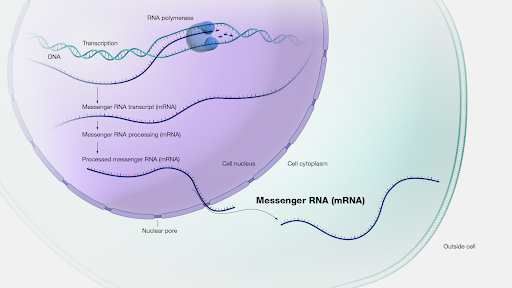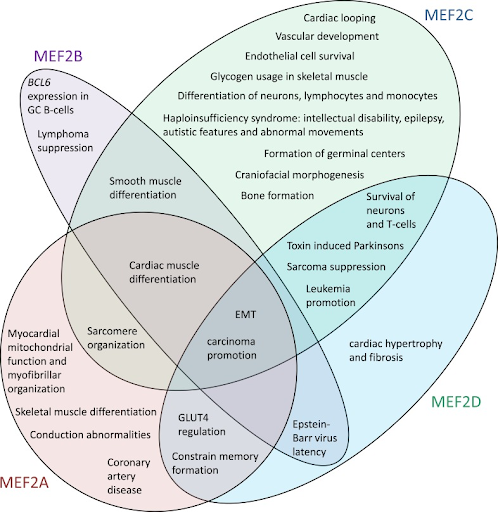Understanding the function of MEF2C in the cell
DNA holds the instructions to make and develop living things, from plants, to animals, to humans. In the human body, DNA helps form proteins that go on to build cells, tissues, and organs.
To understand MEF2C Haploinsufficiency Syndrome (MCHS), we need to understand the role of DNA and proteins in our body.
The human body is made up of trillions of cells. In the nucleus of each cell, there are typically 23 chromosomes from each parent, for a total of 46 chromosomes. Each chromosome contains a strand of DNA.
How do we get from DNA to proteins?
DNA is made of two intertwined strands of genes. In the nucleus, an enzyme called RNA polymerase attaches to the genes and begins to transcribe–or make a copy–of the DNA’s instructions. This copy, otherwise known as the messenger RNA, travels outside of the nucleus into the cytoplasm of the cell. There, ribosomes attach to the messenger RNA and grab amino acids according to the instructions in the messenger RNA. These amino acids are strung together in the order instructed by the DNA to create the ideal protein. MEF2C is one of these proteins.
DNA transcription and translation in the human cell
Image courtesy of National Human Genome Project
Why is the MEF2C protein important?
Once made, the MEF2C protein’s role is to return to the nucleus and regulate other genes in the DNA strands, turning them “on and off.” Imagine MEF2C as the controller of when, where, and the degree to which these certain genes are expressed.
Because of its important role in regulating gene expression, MEF2C is critical to developing healthy muscle, brain, immune, and blood vessel cells.
What is MCHS?
MEF2C Haploinsufficiency Syndrome, or MCHS, is characterized by MEF2C haploinsufficiency. That means that there is a shortage of the MEF2C protein. MEF2C refers to the protein. “Haplo” means only one gene, and “Insufficiency” means too little.
How does MCHS occur?
The MEF2C gene features multiple domains, or sections:
Diagram of MEF2C Gene
In most MCHS cases, very early on in the pregnancy, one copy of the MEF2C gene comes to spontaneously have a small change or missing piece. With only one typical MEF2C gene, those with MCHS can only produce approximately half of the amount of functional MEF2C protein that is needed to properly control gene expression.
What does MCHS mean for the body?
In a typical human, the MEF2C protein acts as a transcription factor, like its sister “MEF2” proteins. That means once the MEF2C protein is made, its job is to return back to the DNA and bind in pairs to different genes to either activate or repress them. Once the appropriate genes are turned on or off, the correct genes can be scanned by the time RNA polymerase starts to read and transcribe the DNA.
For a child with MCHS, the body has less than the functional MEF2C protein it needs, so there are not enough pairs of MEF2C that can bind to the genes necessary for proper development. The result is underdeveloped muscles, brain, immune system, and blood vessels. That’s why children with MCHS often display repetitive behavior, nonverbal and social deficits, seizures, intellectual disability, walking difficulties, hyperactivity, and sleep problems.
Functions of MEF2 Proteins (Pon JR, Marra MA. MEF2 transcription factors: developmental regulators and emerging cancer genes. Oncotarget. 2016 Jan 19;7(3):2297-312)
The effects of MCHS are profound and life-changing. The good news is, we are onto a solution. If too little MEF2C protein is the problem, we can try to increase the presence of MEF2C protein. And that is what our team is working night and day to do for our kids as we #strive4five.



